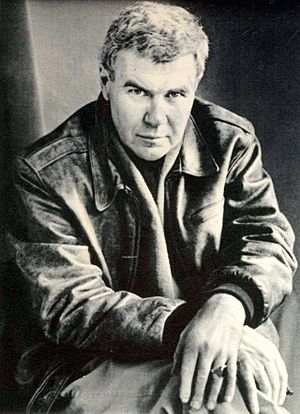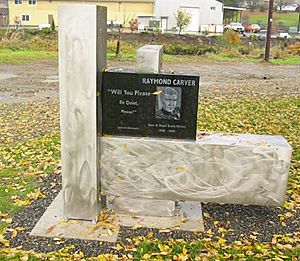Raymond Carver facts for kids
Quick facts for kids
Raymond Carver
|
|
|---|---|

Carver c. 1988
|
|
| Born | Raymond Clevie Carver, Jr. May 25, 1938 Clatskanie, Oregon, U.S. |
| Died | August 2, 1988 (aged 50) Port Angeles, Washington, U.S. |
| Occupation | Writer |
| Nationality | American |
| Period | 1958–1988 |
| Genre | Short story, poetry |
| Literary movement | Minimalism, dirty realism |
| Spouse |
Maryann Burk
(m. 1957; div. 1982)Tess Gallagher
(m. 1988) |
Raymond Clevie Carver Jr. (born May 25, 1938 – died August 2, 1988) was an American short story writer and poet. He is famous for his simple yet powerful writing style. Many people believe he helped make short stories popular again.
Carver published his first collection of stories, Will You Please Be Quiet, Please?, in 1976. His book What We Talk About When We Talk About Love (1981) made him very well-known. His collection Cathedral (1983) is often seen as his best work. Just before he passed away in 1988, he released Where I'm Calling From.
Contents
Early Life and Family
Raymond Carver was born in Clatskanie, Oregon, a town by the Columbia River. He grew up in Yakima, Washington. His father, Clevie Raymond Carver, worked at a sawmill and loved to fish. His mother, Ella Beatrice Carter, worked as a waitress and store clerk. Raymond also had a younger brother, James.
School Days and Hobbies
Raymond went to local schools in Yakima. In his free time, he enjoyed reading novels and magazines like Sports Afield. He also liked to hunt and fish with his friends and family.
Starting a Family
After finishing Yakima High School in 1956, Carver worked with his father at a sawmill in California. In 1957, when he was 19, he married 16-year-old Maryann Burk. They had their first child, Christine, in December 1957, and a son, Vance, a year later. Raymond worked many jobs, like delivery man and janitor, while Maryann also worked to support their family.
Becoming a Writer
In 1958, Carver and his family moved to Paradise, California. He became interested in writing while studying at Chico State College. There, he took a creative writing class with a writer named John Gardner. Gardner became a very important teacher and friend to Carver.
First Published Stories
In 1961, Carver's first story, "The Furious Seasons," was published. It was different from his later work and showed the influence of writer William Faulkner. He continued his studies at Humboldt State College and became an editor for the college's literary magazine, Toyon.
Challenges in College
Carver was accepted into the Iowa Writers' Workshop, a famous writing program, in 1963. However, he missed California and found it hard to fit in. He decided to leave the program after one year. Later, he sometimes incorrectly said he had earned a master's degree from Iowa. His wife, Maryann, continued her education and became an English teacher.
Working and Writing
In the mid-1960s, Carver lived in Sacramento. He worked as a night janitor at a hospital. He would finish his cleaning quickly so he could write for the rest of his shift. During this time, he published his first book of poems, Near Klamath.
In 1967, his story "Will You Please Be Quiet, Please?" was chosen for a collection of Best American Short Stories. He then moved to Palo Alto and worked as a textbook editor. He also made important connections with other writers and editors, like Gordon Lish.
Personal Life and Later Years
New Beginnings
In 1977, Carver met the poet Tess Gallagher at a writers' conference. They felt a strong connection. Starting in 1979, Carver and Gallagher lived together in different places, including El Paso, Texas, and near Port Angeles, Washington.
In 1980, they moved to Syracuse, New York, where Gallagher taught at Syracuse University. Carver also became a professor there. They bought a house together, which became so popular with visitors that they put up a sign saying "Writers At Work" to get some quiet time. In 1982, Raymond and his first wife, Maryann, divorced.
In 1988, just six weeks before he died, Carver and Gallagher got married in Reno, Nevada.
Raymond Carver's Passing
Raymond Carver passed away on August 2, 1988, in Port Angeles, Washington. He was 50 years old and had lung cancer. He was recognized for his writing by being inducted into the American Academy of Arts and Letters that same year.
He is buried in Ocean View Cemetery in Port Angeles. On his tombstone, there is a part of his poem called "Late Fragment":
And did you get what
you wanted from this life, even so?
I did.
And what did you want?
To call myself beloved, to feel myself
beloved on the earth.
Another one of his poems, "Gravy," is also written on his tombstone. After he died, Tess Gallagher took care of his literary works, as he wished.
Awards and Tributes
Carver's first major story collection, "Will You Please Be Quiet, Please," was nominated for the National Book Award in 1977. His book Cathedral (1983) was nominated for the Pulitzer Prize for Fiction. Many people think Cathedral is his best work. It includes famous stories like "A Small, Good Thing" and "Where I'm Calling From".
Carver won the O. Henry Award five times for his short stories:
- "Are These Actual Miles" (1972)
- "Put Yourself in My Shoes" (1974)
- "Are You A Doctor?" (1975)
- "A Small, Good Thing" (1983)
- "Errand" (1988)
In his hometown of Clatskanie, Oregon, there is a memorial park and a statue of Raymond Carver. It is located near the library and the building where he was born.
Writing Style
Raymond Carver mostly wrote short stories and poetry. He said he liked to write things that were "brief and intense." He also said he was "hooked on writing short stories." One reason he kept his stories short was so they could be written and read in one sitting. This was helpful, especially early in his career, when he had to balance writing with his jobs. His stories often focused on the lives of everyday working people, which reflected his own experiences.
Minimalism and Dirty Realism
Carver's writing is often described as minimalist. This means he used very few words and kept his sentences simple. He focused on important details that could mean many things. However, Carver himself did not like to be put into categories.
His editor at Esquire magazine, Gordon Lish, encouraged him to write even shorter. While his earlier teacher, John Gardner, suggested using 15 words instead of 25, Lish told him to use 5 words instead of 15. Carver eventually disagreed with Lish's very strong editing.
Carver's style is also called dirty realism. This style connects him with other writers from the 1970s and 1980s, like Richard Ford and Tobias Wolff. These writers often wrote about the sadness and challenges in the daily lives of ordinary people, especially those who were struggling or felt alone.
Major Works
Fiction Collections
- Will You Please Be Quiet, Please? (1976)
- Furious Seasons and Other Stories. (1977)
- What We Talk About When We Talk About Love (1981)
- Cathedral (1983)
- Elephant and Other Stories (1988) – published in Great Britain
- Beginners (2009)
Collected Stories
- Where I'm Calling From: New and Selected Stories (1988)
- Short Cuts: Selected Stories (1993) – for the film Short Cuts
- Collected Stories (2009) – all his short fiction
Poetry Collections
- Near Klamath (1968)
- Winter Insomnia (1970)
- At Night The Salmon Move (1976)
- Fires (1983)
- Where Water Comes Together With Other Water (1985)
- Ultramarine (1986)
- A New Path To The Waterfall (1989)
- Gravy (Unknown year)
Collected Poems
- In a Marine Light: Selected Poems (1988)
- All of Us: The Collected Poems (1996)
Films and Theatre Based on His Work
Many of Raymond Carver's stories have been turned into movies and plays:
- Short Cuts (1993), directed by Robert Altman, used nine of Carver's short stories and a poem.
- Everything Goes (2004), starring Hugo Weaving, was based on his story "Why Don't You Dance?"
- Whoever Was Using This Bed (2016) was also based on his short story of the same name.
- Jindabyne (2006) was based on his story "So Much Water So Close to Home."
- Everything Must Go (2010), starring Will Ferrell, was based on "Why Don't You Dance?"
- The movie Birdman or (The Unexpected Virtue of Ignorance) (2014) features a play based on Carver's story "What We Talk About When We Talk About Love." The main character, Riggan Thomson, says Raymond Carver inspired him. The film also starts with Carver's poem "Late Fragment." Birdman won four Oscars, including Best Picture.
See also
 In Spanish: Raymond Carver para niños
In Spanish: Raymond Carver para niños


